|
Why
were there so many Cuban and Haitian refugees in 1994?
The
USA is a wealthy country, but many of the small countries
nearby are very poor. Two of these countries are Cuba
and Haiti.
|
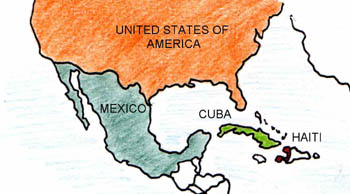 Map
of the Caribbean Map
of the Caribbean
|
In
the United States, the average annual income in 1994
was 23 240 US dollars, but in Haiti the average annual
income was just 250 US dollars. It's no surprise many
people in countries like these see America as a place
where they could be better off.
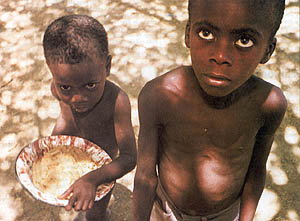
Hungry children in Haiti. Photo
by: Wally McNamee for Newsweek (Masland et al, 1994:
59) |
Repressive
government in Haiti
To make things worse, in 1994 both countries had repressive
governments. At that time Haiti was ruled by a military
junta which took power in a coup. Anyone who disagreed
with the junta was persecuted by the army, or beaten
up or murdered by militia thugs who supported the army.
Many people had to escape because of their political
views.
When
the junta first took power in 1992 more than thirty
thousand Haitians tried to sail to the United States.
They wanted political asylum, in other words, they wanted
to be allowed to live in the USA because they were persecuted
for their political views in Haiti.
But
the United States Government lead by President George
Bush didn't want to let them in. Instead, they sent
back every boatload of refugees without letting them
apply for political asylum.
President
Clinton changes policy
After Bill Clinton became President he changed that
policy. He said it was inhumane to just turn them back
without giving them a chance to apply. In May 1994 Clinton
decided that any refugees who were picked up at sea
would be taken to a ship or another country and interviewed.
They'd be given a chance to apply for asylum.
Once
news of this decision reached Haiti, thousands of people
set sail, in anything they could find that would float.
Some people sold everything they owned to buy a place
on an overcrowded rickety boat. Some boats sank and
hundreds of people drowned. For the next few months,
up to ten thousand Haitians set sail every week.
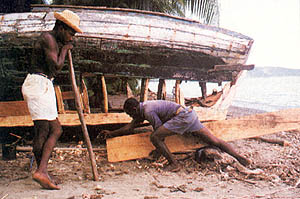
Two Haitian men repair a boat to
sail to America. Photo by Wally McNamee for Newsweek
(Masland et al, 1994: 58) |
At
first the United States kept the refugees on a ship
in Jamaica, but that quickly became overcrowded, so
they moved them to refugee camps in Panama and at a
United States Naval Base at Guantanamo Bay.
The
Cuban situation
In Cuba the story was a bit different. Like Haiti, Cuba
is a poor country. But the United States have a long
history of animosity towards Cuba, ever since Fidel
Castro took over the country in a coup in 1959. Before
that, the United States had very close ties with Cuba,
and Americans owned many of the businesses there. But
Castro threw them out and set up a Communist government.
The
United States never forgave Castro, and they had a rule
that any refugee from Cuba, would automatically be allowed
to stay in the USA. But Castro's government was also
repressive. Many Cubans wanted to go to the USA because
their political views were suppressed, or just because
they wanted a better life, but it was against the law
to try to leave. Many people were put in prison for
trying.
United
States policy changes
But in August 1994 the Cuban Government changed their
policy, they would no longer stop people leaving. For
the first time Cuban people were free to go, and they
knew that they would be allowed to stay in the USA if
only they could get there. Thirty-five thousand set
off in boats or even on rafts to try and paddle across
the Caribbean to Florida. Because so many were trying
to get into America at once, the United States decided
they also had to change their policy. Clinton decided
the Cubans would now be sent to Guantanamo Bay first
and have to apply for entry like everyone else.
By
the end of September 1994, more then 50 000 Cubans and
Haitian were packed into the refugee camp at Guantanamo
Bay.
After
all that, only about 8% to 10% of the refugees were
finally given asylum and let into America. In the end
all the rest were sent home.
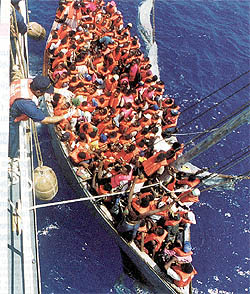
A typical boat jammed with Haitians
is picked up by the US Coastguard. Photo by: Pac
Rick Woods, US Coast Guard (Masland et al, 1994:
60) |
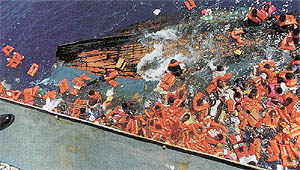
The boat was so overcrowded it turned
over. Photo by: Pac Rick Woods, US Coast Guard (Masland
et al, 1994: 60) |

and the refugees had to be rescued
from the water. Photo by: Pac Rick Woods, US Coast
Guard
(Masland et al, 1994: 60) |
|